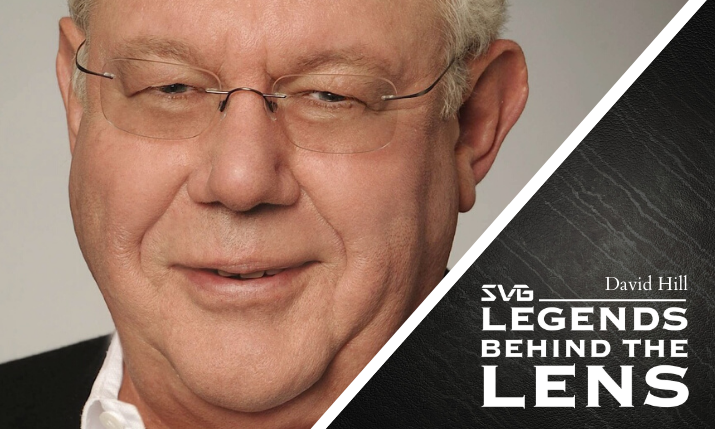Legends Behind the Lens: David Hill
The audacious Aussie is one of the most transformative figures in American sports television history
Story Highlights

The story of American sports television is engrained in the history of this nation, rising on the achievements of countless incredible men and women who never once appeared on our screens. During this pause in live sports, SVG is proud to present a celebration of this great industry. Legends Behind the Lens is a look at how we got here seen through the people who willed it to be. Each weekday, we will share with you the story of a person whose impact on the sports-television industry is indelible.
Legends Behind the Lens is presented in association with the Sports Broadcasting Hall of Fame and the SVG Sports Broadcasting Fund. In these trying times — with so many video-production professionals out of work — we hope that you will consider (if you are able) donating to the Sports Broadcasting Fund. Do so by visiting sportsbroadcastfund.org.
___________________________
By Brandon Costa
David Hill is the man who crashed the party — and became the life of it.
The Australia-born business leader dramatically changed sports television in multiple countries with his innovative mind and magnetic persona.
Hill led the launch of News Corp.’s sports division in 1993 and instantly made a splash with technical innovations, including the Fox Box and the Glow Puck, the ancestor of advanced graphics elements, such as the 1st-and-10 line. All were rather demented ideas at the time: imagine, an Aussie telling Americans how to better watch their football.
“I think they invented the expression ‘thinking outside the box’ for David Hill,” says Dallas Cowboys owner Jerry Jones, a key NFL representative in Fox’s negotiations for the league’s broadcast rights. “Some people have a natural ability to see things the way they are and know how to make them better. David knew something that a lot of people had lost sight of through the years: that sports is entertainment and should be fun.”
Hill’s career began rather humbly, as a 17-year-old copy boy at the Sydney Daily Telegraph. He worked as a reporter until moving to television at 19, finding a home at Nine Network, where he worked on the Australian version of Today.
Moving up to VP, sports, with Nine, Hill attracted the attention of media mogul Rupert Murdoch. Hill joined 21st Century Fox and relocated to Great Britain in 1988, helping launch Sky Television, Britain’s first satellite-TV station, and introducing Eurosport, a pan-Europe, multilingual sports channel.
“Many didn’t understand it, including the advertisers,” says Hill. “None of this had ever been done before. We were faced with immense day-by-day problems in terms of production. It was seven days a week, 16-17 hours a day.”
When Sky Television merged with British Sky Broadcasting in 1990, Hill took over BSkyB sports channel and created Sky Sports in 1991. It was at Sky that he experimented with putting the time and score on-screen, for English Premier League matches.
“I think they invented the expression ‘thinking outside the box’ for David Hill. Some people have a natural ability to see things the way they are and know how to make them better. David knew something that a lot of people had lost sight of through the years: that sports is entertainment and should be fun.” – Dallas Cowboys owner Jerry Jones
In 1993, Fox nabbed NFL U.S. broadcast rights. Hill was a part of the negotiations that spurred the league to take a chance on the upstart network.
Murdoch named him president of Fox Sports, and, under his direction, a sports division grew from the ground up in just eight months, with state-of-the-art studios and onsite broadcast facilities for a futuristic feel on-screen. Explosive theme songs, robots, neon pucks: Fox Sports developed an indelible identity.
“He’s as knowledgeable and passionate about sports as anyone in broadcasting, and he has a creative streak that is incomparable,” says NHL Commissioner Gary Bettman, whose league partnered with Fox from 1994 to1999. “He thinks about things not as they are but as they could be, and he lets his imagination run wild. He truly is one of a kind.”
Many of Hill’s innovations made sports more accessible to the casual audience. None had more impact than the yellow 1st-and-10 line, which he developed with Sportvision’s Stan Honey.
“I didn’t grow up watching American football,” says Hill, “and it made it easier for me to understand what was going on. Simple as that!”
Under Hill, Fox also dove into baseball, grabbing national rights in 1996, including that year’s World Series. The Fall Classic has aired on Fox every year since 2000.
“I could tell from the first meeting, this guy is going to change the way the game of baseball is seen on television,” says Paul Beeson, former president of Major League Baseball and current president of the Toronto Blue Jays. “There’s an irreverence to him, and there’s a professionalism to him. You knew he was going to do things differently, but you knew he was going to do it better.”
Hill added duties over the years, serving as chairman/CEO of Fox Broadcasting from 1997 to ’99, president of DIRECTV’s entertainment division from 2005 to ’07, and chairman/COO/executive producer of National Geographic Channel. He ended his run at Fox in 29015 and actually began dipping his toe into the world of esports when he joined on with ESL in 2017. Traditional sports, however, still hold a special place in his heart.
“Sports are a lot of fun,” says Hill. “If you understand that the secret of life is to have a really good time and you consider what we do for a living, which is producing sports, it doesn’t get better than that.”
The video in this profile was originally produced in 2014. For more on the life and career of this industry legend, visit their profile at the Sports Broadcasting Hall of Fame.
